On a recent trip to the Apalachicola National Forest, my friend Sharol and I were determined to find blooming pitcher plants. These carnivorous beauties are part of what make the panhandle region of our state special, and the 2020 spring bloom did not disappoint! The pitcher plants are the showiest of the carnivorous plants, and sport specialized leaves with tubular throats into which insects wander to their doom. The bog environment where the plants thrive is surprisingly poor in nutrients, so these plants have become carnivorous to supplement their diet.
How to Find Pitcher Plants
Sharol’s photographer friend gave us directions to the general vicinity of some blooming plants, and on our first afternoon we drove north on SR 65. I’ll give you the same directions we were given . . . just look on the roadsides north of Sumatra. It sounds vague, but it was enough to get us where we needed to be! Once you see the first few plants, the next ones are easier to find. I saw one pitcher within 10 feet of the road, then a cluster of three just a bit farther back. Then suddenly it was as if they were EVERYWHERE!
We Found Them!
What we were seeing were yellow pitcher plants (Sarracenia flava). These plants are so variable in color that I first thought we were seeing three different plants. Most were vivid yellow, but some had a greenish cast. Some had a red blotch on the throat of the pitcher. Others were deeply veined with red. In fact, each of these is a common color variation for this plant.
After last year’s experience seeing the delicate and endangered white pitcher plants(S. leucophylla), I was surprised at how robust these plants looked. The pitchers were taller and wider than the white plants. The walls of the pitchers were so thick that some of the plants appeared to be make of wax or plastic. There was nothing delicate about these! Many of them reached to the middle of my thigh, and I’m a tall woman. The yellow pitcher plant is the only Florida pitcher that is not threatened or endangered.
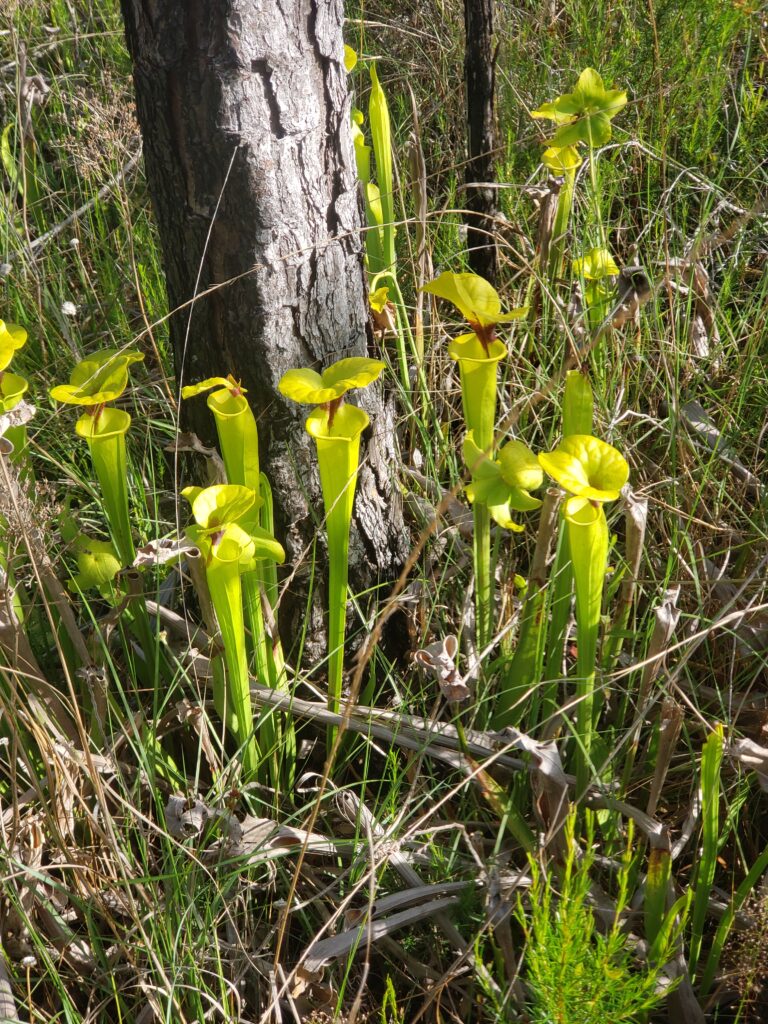
Sundew Discovery
A bit farther back from the road, we noticed two types of sundew, another carnivorous plant. Venus flytraps, native to the Carolinas, are probably the best known member of the sundew family. Of course we did not see them on this trip. The first sundew we encountered was dwarf sundew (Drosera brevifolia) . This wee plant grows directly on the ground, appearing as tiny orange paddles organized around a central point. These paddles are covered with numerous hairs, each with a drop of nectar on the tip. I’m not sure why I expected that the nectar would be sweet, but I tried it and am disappointed to report that it’s tasteless.
When an insect walks across one of these paddles, the nectar and hairs work in concert to trap it. As nectar clogs its breathing spiracles, the hairs may fold in to physically trap an insect. Eventually the plant digests the critter. Later, we found thread leafed sundew (D. filiformis) (see title picture) ,which reaches for the sun from a coil that looks like the fiddlehead of a fern. The ones we saw were about 6” tall. The pillars of these plants are covered with hairs, and each of those hairs has the characteristic nectar. Just like pitchers, sundews have adapted to use insects to supply nutrients they can’t get from the bog.

When we first noticed the sundew, I photographed what I think is a Gulf purple pitcherplant (S. purpurea), threatened, and pictured in the title of this post. I only got the one shot, so I am not so certain that I want you to use that picture as Gospel, but I’m certain enough that I’m going to claim it in my pitcher plant count.
Parrot Pitcherplant Uses a Unique Trap
As I was poking at some dwarf sundew, I noticed parrot pitcher plants (Sarracenia psittacine), threatened. These grow so close to the ground that I might not have noticed them if they had not been in bloom – and this makes them easy to trample, which is no doubt part of why they are listed as threatened. The bloom is about 8” tall, but the leaves remain within an inch or two of the ground. These plants have developed an interesting strategy to trick their victims into staying inside the plant: when an insect crawls in, the top of the pitcher is very dark, but the bottom of the pitcher is thin enough to allow light inside. The poor insect crawls toward the light, not realizing the trick that’s being played on it. Parrot pitchers are the only pitcher to use this method of entrapment.
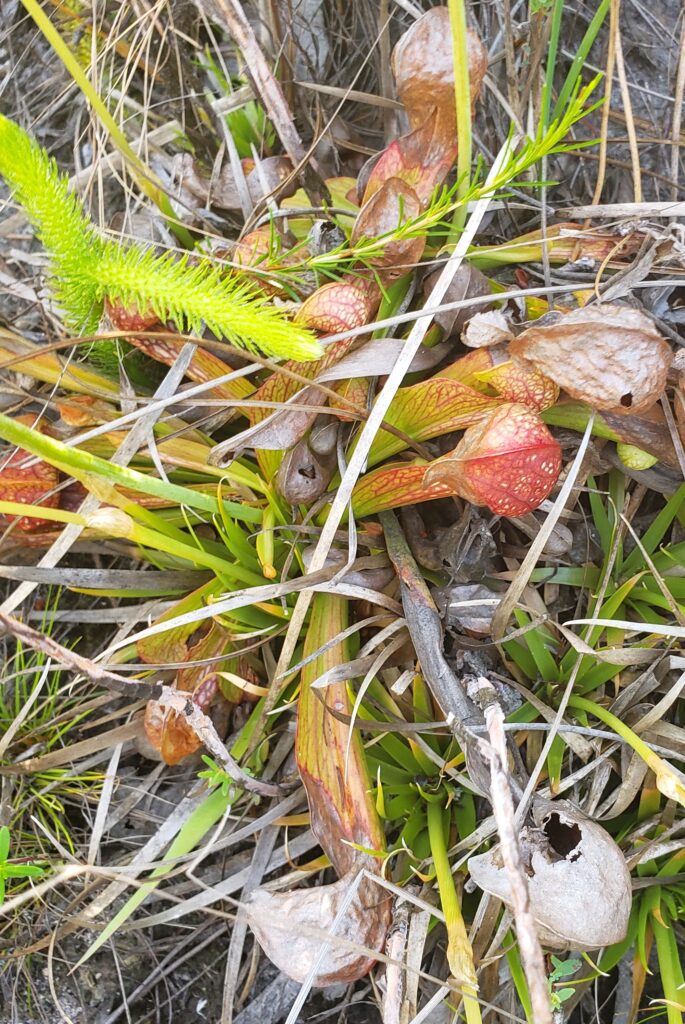
After a couple of hours of carnivorous plant bliss, we packed it up and headed for our home away from home. We planned to get up early and return to the forest for more plant hunting, and that’s just what we did.
Wright Lake Recreation
On our second day, we had decided to check out the Wright Lake Recreation area because there was a trail that is known for good pitcher plant displays. The trail is publicized as a simple loop, marked with blue blazes. We figured we would spend a few hours on the trail and then head to a state park to soak up some sunshine. Wright Lake was easy enough to find, with good signage directing us a couple miles off SR 65. While the recreation area was closed to camping due to a water leak, the Forest was open for hiking, so we parked outside the gate and hiked in to find the beginning of the trail.
Spectacular Hiking
We easily found the blue blazes that marked the trail, and off we went. This trail is a spectacular catalog of plant communities, including pine flatwoods, seepage slopes/wet prairies, dome swamps/depression marshes, swamp lakes, baygalls, basin swamps, and floodplain swamps. The Apalachicola Forest is largely expansive pine flatwoods, and as with most National Forests in Florida, the longleaf pine appears to have been replaced with slash pine (although we did find some young longleafs trying to stage a comeback).
It took several hours to reach the wet prairies that are home to the Wright Lake pitcher plants, and along the way we enjoyed the trail with its changes of scenery dependent on elevation. We snacked on wild blueberries and picked out one plant after another to try to identify when we sat down later with our photos and field guides.
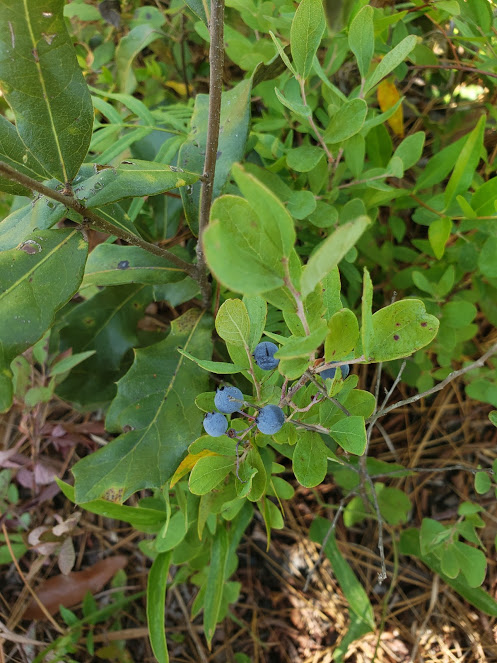
Because we were on a marked trail, we did not get as close to the pitchers as we did on our first day. However, I want to mention that we noticed the sundew on the trail before we saw the pitchers, so those may be a good marker if you are on the hunt in another area.
I would have liked to get closer to the yellow pitcher plants because they looked enormous. Whether this was because we were in a remote area with less foot traffic or because there were less automotive fumes, these plants put on a spectacular display. We noticed parrot pitchers immediately off the trail. As we moved away from this first community of pitcher plants and crossed the forest road, we lost the trail.
The Simple Loop Trail is Not So Simple
In the distance, we could see another community of yellow pitchers along a line of pines, and it looked like a good place to put a trail, so we headed off to see if we could find any further blue blazes. We were not successful, and while walking, we kept seeing parrot pitchers under our feet, so we turned back to the road. At very distant intervals, we noticed random blue blazes, but did not see a trail.
Sharol and Pam Get Lost in the Woods
I like to use Map My Run, a mobile app, when I’m hiking, so that I can see how much ground I’ve covered. There have been times where the map layer has helped me get myself out of trouble, but we were far enough from signal that the underlying map was not displayed. However, the actual route we had taken was marked.
Looking at that route, it looked as if an unpaved road could lead us back to our starting point, but we quickly realized that the road only led to an area of red cockaded woodpecker nests and then into a swamp, so we turned back to the limerock forest road. At some point, even the route marking was not displayed so Map My Run was no longer helpful.
As we continued on the forest road, we noticed an area to our left with blue blazes on every tree. Clearly, something had gone awry and the trail was permanently lost to us. Eventually we came to a camping area and saw water through the trees – I was sure this was the back side of Wright Lake, and we picked up speed to get to the sign – which told us we were at Otter Creek and not Wright Lake. By this time, neither of us had water left, and we were disappointed when we realized that we had another couple of miles to get back to the car. It was hard to tell exactly how far from the car we were, because the map did not have a scale.
Artesian Well at Otter Creek
An artesian well pumping malodorous, but icy cold, water was a welcome sight. I soaked my hair and my shirt to keep myself cool but was neither brave nor desperate enough to try drinking that stinky stuff! We headed back up the road in full mid-day sunshine, viewing sporadic pitchers and endless pine flatwoods.
By the time Sharol spotted the glint of the car, we were exhausted. The air conditioning quickly refreshed us and we decided that in spite of a situation that could have been dire, we would happily repeat the morning.
So, now I have seen four of the six Florida pitchers in the wild. Will 2021 bring me the remaining two? I sure hope so!
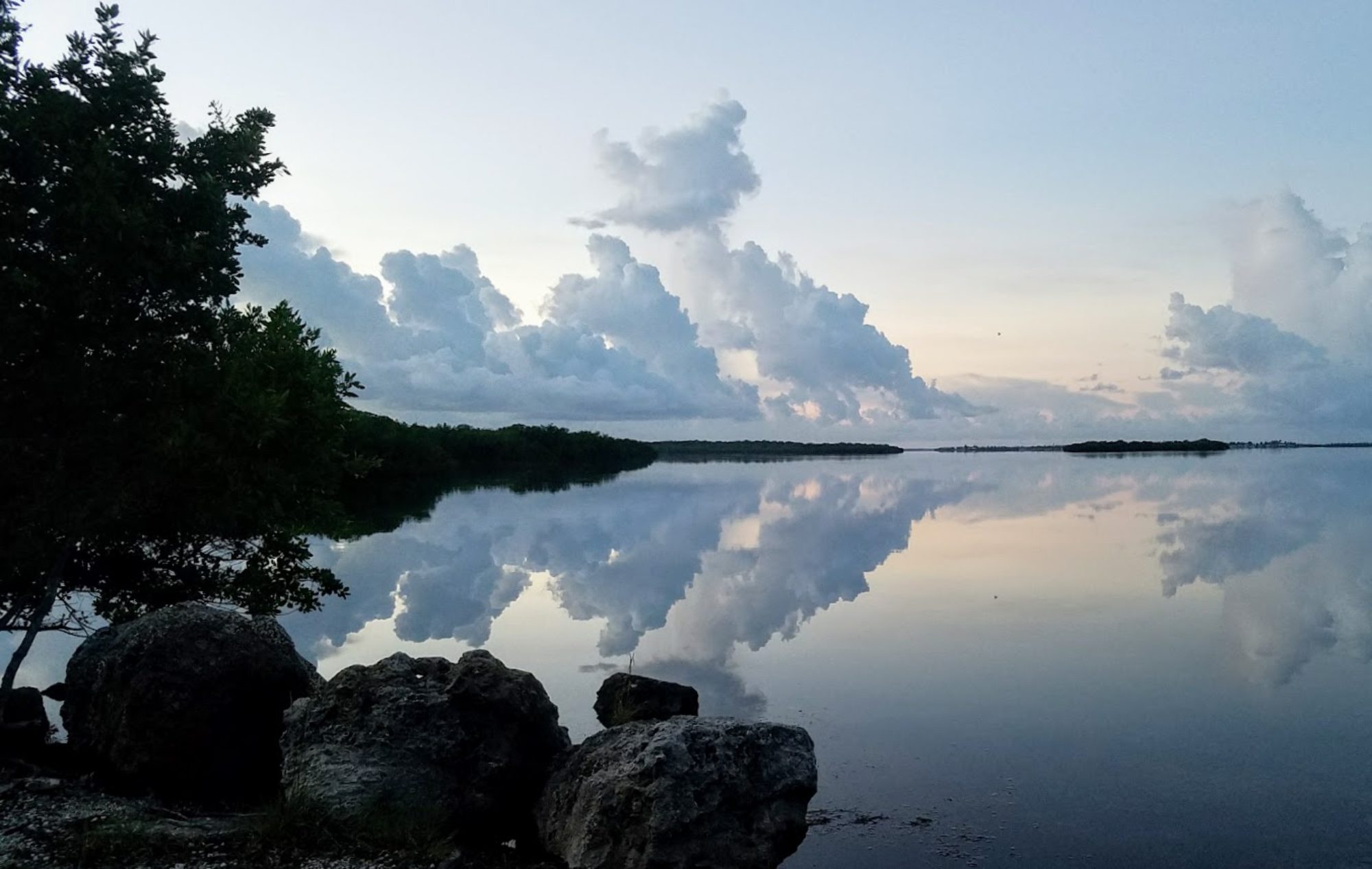
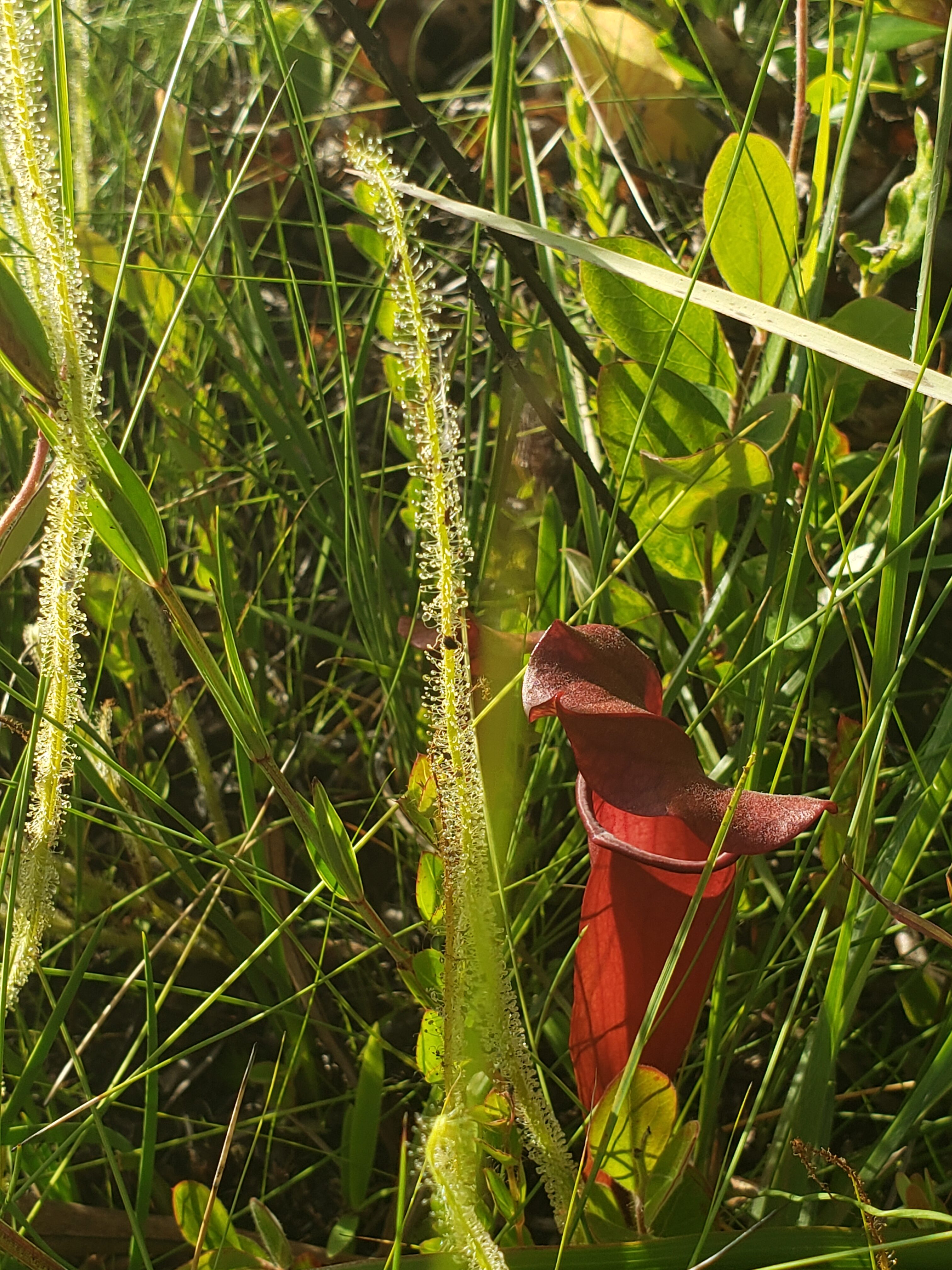
What a neat experience! I do not normally look for certain plants on hikes, but this sounds like a fun adventure. I hope you are able to find the other two types!
Beautiful descriptions and photographs! I’m enjoying relearning my home state’s beauty through your blog, Pam <3
Jackie, it just tickles me knowing you are reading. Thanks so much!
How cool is this? I have never seen the pitcher plants in the wild. And did they really evolve into bug eaters because of the lack of nutrients? That’s a very interesting fact, I think. Next time I get up to the panhandle, I’m going for it. Love this post.
https://www.sciencemag.org/news/2020/05/how-venus-flytraps-evolved-their-taste-meat
Found the link!
Jenny, I recently read in Science magazine that it is likely that ALL plants have the necessary genetic material to become carnivorous…it just doesn’t switch on. It appeared the week after I came home…I will see if I can find a link and put it here for you.
This is so cool! I love Florida’s native plants. Now I have to make a trip to this area to see the pitcher plants.
I hope you get to see the other 2 as well. There are so many great native plants here in Florida.
Absolutely love the Panhandle, and you have just given me another reason to get back there! I had no idea that there were cannibal plants there! Have you been to Watercolor?
Haven’t made it to Watercolor, but it’s probably in my future!